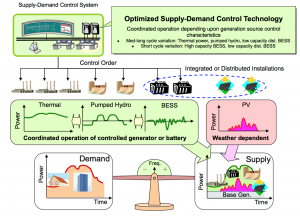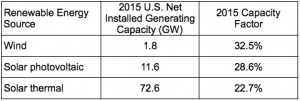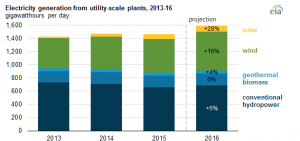Peter Lobner
On 3 March 2015, Mitsubishi Electric Corporation announced the delivery of the world’s largest energy storage system, which has a rated output of 50 MW and a storage capacity of 300 MWh. The battery-based system is installed in Japan at Kyushu Electric Power Company’s Buzen Power Plant as part of a pilot project to demonstrate the use of high-capacity energy storage systems to balance supply and demand on a grid that has significant, weather-dependent (intermittent), renewable power sources (i.e., solar and/or wind turbine generators). This system offers energy-storage and dispatch capabilities similar to those of a pumped hydro facility. You can read the Mitsubishi press release at the following link:
http://www.mitsubishielectric.com/news/2016/pdf/0303-b.pdf
The energy storage system and associated electrical substation installation at Buzen Power Plant are shown below. The energy storage system is comprised of 63 4-module units, where each module contains sodium-sulfur (NaS) batteries with a rated output of 200 kW. The modules are double stacked to reduce the facility’s footprint and cost.
The following simplified diagram shows how the Mitsubishi grid supervisory control and data acquisition (SCADA) system matches supply with variable demand on a grid with three dispatchable energy sources (thermal, pumped hydro and battery storage) and one non-dispatchable (intermittent) energy source (solar photovoltaic, PV). As demand varies through the day, thermal power plants can maneuver (within limits) to meet increasing load demand, supplemented by pumped hydro and battery storage to meet peak demands and to respond to the short-term variability of power from PV generators. A short-term power excess is used to recharge the batteries. Pumped hydro typically is recharged over night, when the system load demand is lower.
Above diagram: Mitsubishi BLEnDer® RE Battery SCADA System (Source: Mitsubishi)
Battery storage is only one of several technologies available for grid-connected energy storage systems. You can read about the many other alternatives in the December 2013 Department of Energy (DOE) report, “Grid Energy Storage”, which you can download at the following link:
http://www.sandia.gov/ess/docs/other/Grid_Energy_Storage_Dec_2013.pdf
This 2013 report includes the following figure, which shows the rated power of U.S. grid storage projects, including announced projects.
As you can see, battery storage systems, such as the Mitsubishi system at Buzen Power Plant, comprise only a small fraction of grid-connected energy storage systems, which currently are dominated in the U.S. by pumped hydro systems. DOE reported that, as of August 2013, there were 202 energy storage systems deployed in the U.S. with a total installed power rating of 24.6 GW. Energy storage capacity (i.e., GWh) was not stated. In contrast, total U.S. installed generating capacity in 2013 was over 1,000 GW, so fully-charged storage systems can support about 2.4% of the nation’s load demand for a short period of time.
Among DOE’s 2013 strategic goals for grid energy storage systems are the following cost goals:
- Near-term energy storage systems:
- System capital cost: < $1,750/kW; < $250/kWh
- Levelized cost: < 20¢ / kWh / cycle
- System efficiency: > 75%
- Cycle life: > 4,000 cycles
- Long-term energy storage systems:
- System capital cost: < $1,250/kW; < $150/kWh
- Levelized cost: < 10¢ / kWh / cycle
- System efficiency: > 80%
- Cycle life: > 5,000 cycles
Using the DOE near-term cost goals, we can estimate the cost of the energy storage system at the Buzen Power Plant to be in the range from $75 – 87.5 million. DOE estimated that the storage devices contributed 30 – 40% of the cost of an energy storage system. That becomes a recurring operating cost when the storage devices reach their cycle life limit and need to be replaced.
The Energy Information Agency (EIA) defines capacity factor as the ratio of a generator’s actual generation over a specified period of time to its maximum possible generation over that same period of time. EIA reported the following installed generating capacities and capacity factors for U.S. wind and solar generators in 2015:
Currently there are 86 GW of intermittent power sources connected to the U.S. grid and that total is growing year-on-year. As shown below, EIA expects 28% growth in solar generation and 16% growth in wind generation in the U.S. in 2016.
The reason we need dispatchable grid storage systems is because of the proliferation of grid-connected intermittent generators and the need for grid operators to manage grid stability regionally and across the nation.
California’s Renewables Portfolio Standard (RPS) Program has required that utilities procure 33% of their electricity from “eligible renewable energy resources” by 2020. On 7 October 2015, Governor Jerry Brown signed into law a bill (SB 350) that increased this goal to 50% by 2030. There is no concise definition of “eligible renewable energy resources,” but you can get a good understanding of this term in the 2011 California Energy Commission guidebook, “Renewables Portfolio Standard Eligibility – 4th Edition,” which you can download at the following link:
http://www.energy.ca.gov/2010publications/CEC-300-2010-007/CEC-300-2010-007-CMF.PDF
The “eligible renewable energy resources” include solar, wind, and other resources, several of which would not be intermittent generators.
In 2014, the installed capacity of California’s 1,051 in-state power plants (greater than 0.1 megawatts – MW) was 86.9 GW. These plants produced 198,908 GWh of electricity in 2014. An additional 97,735 GWh (about 33%) was imported from out-of-state generators, yielding a 2014 statewide total electricity consumption of almost 300,000 GWh of electricity. By 2030, 50% of total generation is mandated to be from “eligible renewable energy resources,” and a good fraction of those resources will be operating intermittently at average capacity factors in the range from 22 – 33%.
The rates we pay as electric power customers in California already are among the highest in the nation, largely because of the Renewables Portfolio Standard (RPS) Program. With the higher targets for 2030, we soon will be paying even more for the deployment, operation and maintenance of massive new grid-connected storage infrastructure that will be needed to keep the state and regional grids stable.




